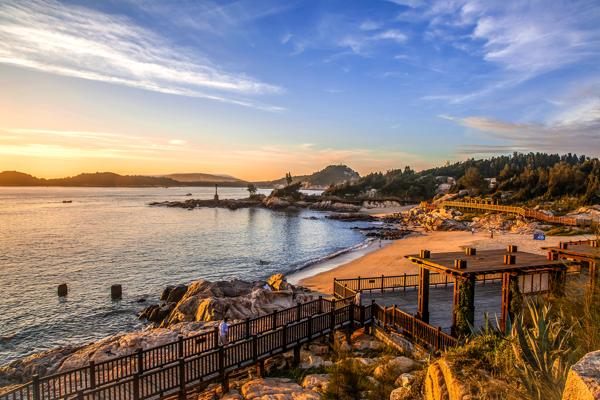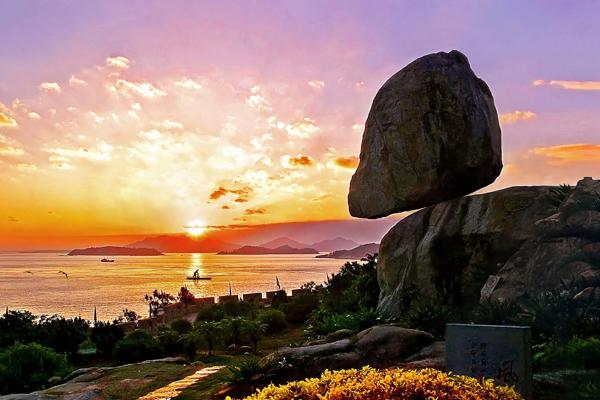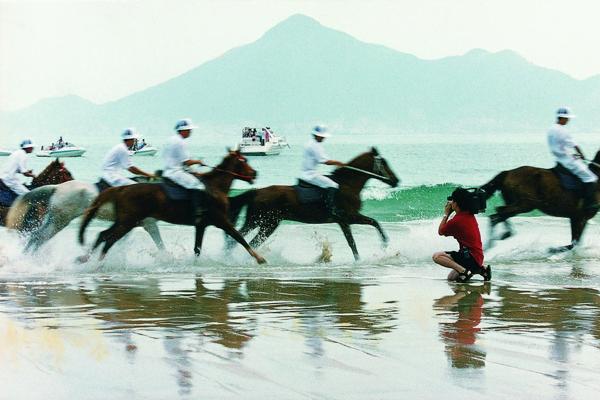
Walking along the beach near Feng Dong Shi.[Photo/Provided to China Daily]
Dongshan in Fujian province offers rich coastal cultural heritage
Whether your dream island trip in China is to spend a few days sunbathing on white beaches, or to explore the rich coastal history heritage of this country, Dongshan county offers both choices.
Perched on southeast China’s sunny coast less than one kilometer east of Fujian province, Dongshan is China’s sixth largest island and is edged by seven beaches, with sparkling water and white sand.
Serially connected, the seven beaches stretch to 30 km. Ma Luan Wan, the most popular beach, is 2,500 meters long and 60 meters wide. The waters here are relatively calm, and there’s plenty of sand to build castles or simply to sunbathe.
Ma Luan Wan is also known for its not-to-be-missed sunrise and great views of leafy mountains. Ninety-four percent of the island is covered by forests, mostly banyan trees, thanks to six decades of tree planting. The soft air enveloping the island blends into a beautiful banyan-fringed haze.
In 2013, Dongshan was listed among Fujian’s “ten most beautiful islands” by the provincial government. It is also a provincial-level reef conservation site and a national biodiversity reserve.
In addition to swimming and sunbathing, beachgoers here can snorkel or ride boogie boards. Dongshan is also a kite-flier’s dream, with wide flat natural beaches and enduring winds. In 2014, kite-fliers from Hong Kong and other coastal areas came to Dongshan for an international kite-surfing contest, which the county has been holding for years.
On the day I visited the island, the turquoise water was relatively shallow and the sands sparkled against a backdrop of towering granite boulders, worn by time and weather. One of the rocks, Feng Dong Shi, or “rock moved by wind”, is Dongshan’s landmark and the most photographed site.

Sunrise in Feng Dong Shi, meaning ‘rock moved by wind’, which is Dongshan’s landmark.[Photo/Provided to China Daily]
It is a 200-ton rock, more than 4 meters in height, width and length, standing on a bigger rock with its tip. It used to be a part of the bigger rock, but had been gradually separated by water and weather. The locals say the rock will roll back and forth when the wind blows, but will never fall. It also shakes when people give it a shove, but touching the rock is strictly prohibited, to protect the unique site. The tumbler rock has been carved with poems and calligraphy, and is regarded as a spectacle and sacred place on the island.
In the 1980s, a television series, Journey to the West, based on one of the four greatest classical novels of Chinese literature, was filmed near the rock. There was a scene of the Monkey King being born from the stone. The popular series introduced Dongshan to a national audience and it became well known.
In 2014, Dongshan received more than 3 million tourists, 30 percent higher than the previous year, and its tourism revenue was 2.7 billion yuan ($435 million), 67 percent higher than the number in 2013.

Fishermen at work[Photo/Provided to China Daily]
But the island is not ready for visitors who want to spend a few pampered nights in a five-star resort, as it has only just begun to build luxury hotels which could be open to the public in two years’ time. Most hotels now are small and old and the restaurants are really large stalls on the streets. But they will give you an experience of living in a small island which is home to 210,000 people.
A five-minute walk from the shaking rock is a temple of Guan Yu, a historical site in Dongshan. Chinese President Xi Jinping reportedly took a photo with his wife in front of the temple in the 1980s, when they visited the island. The president is said to have the picture in his office as a memento of his early political career in Fujian. Many visitors stand at the same spot where the president and first lady supposedly stood, to take pictures of themselves.
The Guan Yu Temple dates back to the Ming Dynasty (1368-1644). Guan Yu was a general in the Three Kingdoms period (AD 220-280). Seen as an epitome of loyalty and righteousness, Guan is still worshipped today by many Chinese people. Temples and shrines dedicated exclusively to Guan can be found on the Chinese mainland, Hong Kong, Macao, Taiwan, and other places with Chinese influence such as Vietnam and Japan.

People celebrate the birthday of Guan Yu, which falls on May 13, in front of the Guan Yu Temple in Dongshan.[Photo by CHEN XIAOHAN/CHINA DAILY]
The Guan Yu Temple in Dongshan is one of the four most famous of its kind in China. The other three are in the provinces of Shanxi, Henan and Hubei.
The 650-square-meter temple was built in the architecture style of the southeast coastal area, having exquisite ceramic sculptures on its roof.
There are 120 characters on its roof which tell historical stories, including a story on Mu Guiying, a female general in the Song Dynasty (AD960-1279).
Sun Liqiang, 50-year-old ceramic artist, says making the sculptures is a provincial culture heritage. His father, Sun Qijia, repaired the sculptures on the temple’s roof.
“Now I am the only inheritor of the skills,” says Sun. “I hope people would protect the unique art form in Dongshan.”
On Guan Yu’s birth and death dates-May 13 and June 24 in the Chinese calendar-elaborate ceremonies are held in the temple. They are the most important events for the locals.

Horse racing on the beach[Photo/Provided to China Daily]
Wearing traditional long gowns, residents chant and bow in the ceremonies, and pray for good luck and prosperity. Every year, in the first or second month in the Chinese calendar, Dongshan has a parade of Guan’s statue. Carried by local male residents, the statue is carried around the island, followed by bands and honor guards. Locals believe places where Guan has “inspected” will flourish. Today, the ceremonies and parade have become important cultural events that attract thousands of visitors.
The worship of Guan Yu was introduced to Taiwan at the end of the Ming Dynasty, when a general named Zheng Chenggong went across the straits and drove away the Dutch colonists. Now Taiwan has more than 1,000 Guan Yu temples, which have their origins in Dongshan.
Located 300 km from Taiwan’s southern city Kaohsiung, Dongshan is also an exchange platform across the straits. It is one of the first mainland ports opened to Taiwan. There are at least 200,000 people in Taiwan who have their original homes in Dongshan.
